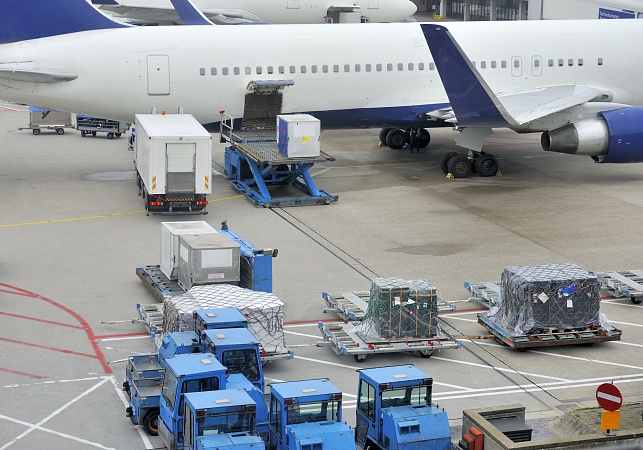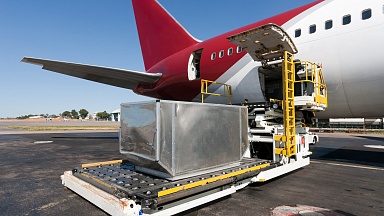In order to limit its impact, there needs to be greater collaboration between the different parties in the sector, particularly with regard to shipment data, according to one Frankfurt-based ground handling agent – a sentiment also shared by many major international cargo handlers.
‘New normal’
Nina Strippel, COO and branch manager at air cargo ground handling company LUG, told a recent air freight webinar organised by Denmark-based forwarder Scan Global Logistics: “In March 2020, when the pandemic began to gain momentum, all of us felt like the world had been closed for an unspecified period of time with the mass cancellation of airline passenger services. Our concern was that air cargo would be heavily affected and one of the first measures we took was to put an immediate stop to our hiring process.
“But when we look at the air cargo traffic statistics for Frankfurt Airport over the course of the pandemic, they show that tonnage has remained relatively stable and that the long-term trend of volumes rising year on year has been maintained and there is every reason to expect that this will continue in the future as well.
“Digging a little deeper into the statistics, they highlight that with the pandemic taking its course, we experienced a huge increase in the number of pieces while the average weight per piece went down and the reason for that was we were handling ‘mountains’ of masks, gloves and other equipment for protection against Covid-19.”
The surge in PPE shipments has now passed, but the ‘new normal’ type of air cargo it spawned continues to thrive, driven largely by the boom in cross-border e-commerce.
Recruitment crisis
Focusing on what this ‘new normal’ means for cargo handling agents, Strippel noted: “Coming back to the number of pieces and the average weight per piece, small and loose shipments require a lot more manpower compared to freight that can be moved by forklifts. Hiring staff has become extremely difficult, and to talk of a recruitment crisis is no exaggeration.
“The upshot is that the cargo handling agent now stands as a ‘bottleneck’ in the overall supply chain and indeed this has been the case since the beginning of the pandemic and remains so today.”
Lack of information
In order, to reduce the ‘bottleneck’ in cargo handling as much as possible, the different parties in the air cargo sector need to work together and share shipment data, Strippel argued.
“This is something all players could do; but in most cases, we have no information about the shipment’s tonnage, the number of pieces, the weights or anything else before a flight takes off at origin. This means that in the best case of a long-haul flight, we can only finalise our shift planning 11 hours in advance, which is no time at all even if you have a lot of flexibility built-in to your operation. The data is of course available at a much earlier stage and sharing it would help all parties involved to speed up the process, much to the benefit of everyone.”
Although there have been several examples of greater collaboration and sharing of cargo handling resources at some airports during the pandemic, this remains a limited and perhaps temporary phenomenon, industry sources say.
‘Preighters’ weigh on productivity
Strippel also highlighted that ‘preighters’ – passenger aircraft in cargo-only configuration – a feature of Covid-19 times, have also contributed to the ‘bottleneck’ in ground handling.
“It’s a lot more time-consuming to load and unload a ‘preighter’ (than a ‘pure’ freighter) with shipments positioned not only in the cargo compartments of the aircraft, but also in the cabin – either on the passenger seats or on the deck when the seats had been completely removed. The process in the warehouses becomes much more manual too, due to the many single boxes that need to be handled. This has weighed on ground handlers’ productivity and driven up operating costs.”
‘Serious obstacles’
Returning to the issue of data sharing between the various stakeholders in the air cargo industry, Strippel said there was often resistance to this “out of fear of being too transparent, giving too much information away to the possible detriment of the individual success of the company”.
She continued: “The serious obstacles to co-operation in the industry are illustrated in the following example: We asked some freight forwarders if they could share with us the data ‘capture’ they had for a particular shipment, the aim being to work together on the basis of having exactly the same information at our disposal.
“The response we received from one forwarder was that the company was paying its employees to enter the data into their system and that if they shared it with us this would amount to them incurring all the cost while we’d be “saving money” so to speak. Frankly, I was shocked by this reply but at least it was an honest one and showed how difficult it is for our industry to work on common goals.
“But if you look at the same example from a different angle, we could also come to the conclusion that if the freight forwarder shared its data with the ground handler we would gain time and reduce the risk of mistakes. This would be to the advantage of the whole supply chain with the end-customers receiving their freight faster and in good condition.”
In conclusion, Strippel underlined once more the importance of collaboration between all parties and the need of digital platforms for data sharing. She also appealed “for trust amongst the various players with the focus on the common goal: to provide a fast and safe transportation process.”
Recent improvements
Several cargo handling sources report that there have been significant improvements in the sharing of data among some leading airport cargo communities and data sharing platforms in the last three years, which has accelerated in some cases during the pandemic.
The latest issue of Cargo Airports & Airlines Services (CAAS) highlights that with digital cargo data becoming increasingly available from multiple sources, handlers and their customers are beginning to see the benefits of greater visibility on the ability to analyse and improve the efficiency of their operations – although this is still at an early stage.
Visibility of air freight containers and pallets has also improved with the deployment of Bluetooth readers and tags to track and digitalise the movements of ULDs, a process that is now well underway among the major multinational cargo handlers.
And some of the benefits have been immediate – and go well beyond the ability of carriers and handlers to keep track of the ULDs themselves. “From the moment we had them installed, forwarders were able to collect shipment data on these readers as well,” reported Hendrik Leyssens, Swissport’s vice president for global cargo operations. “Previously our facility was a bit of a black hole for them. Now they can collect data, for example temperature data for pharmaceutical goods.”
And the flow of data between handlers, airlines and forwarders is showing signs of improving, according to Rory Fidler, vice-president for cargo technology at Menzies Aviation. “Airlines and forwarders are getting to the point of shedding the paranoia about sharing the air waybill data on a platform,” Fidler told CAAS.
But the progress so far remains rather slow. “In digital data flows, I don’t think a huge step forward has happened, but I think where we will start to get quick acceleration is in airport cargo community systems,” he commented.




